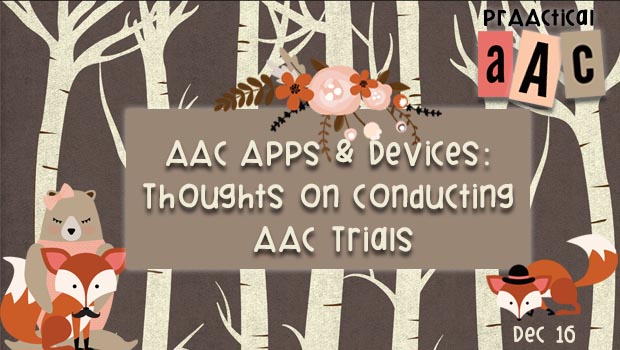AAC Apps and Devices: Thoughts on Conducting AAC Trials

In an earlier post, we talked about why a period of trial use with multiple AAC devices and/or apps is an important part of the process of selecting a communication tool. As with test driving a car prior to purchasing it, giving clients an opportunity to use the AAC options that have the features they need allows us to better determine whether it is likely to meet their needs and expectations. Few of us would purchase a car without taking it out for a spin.
It makes a lot of sense, but what does the ‘test drive’ equivalent look like in AAC? What makes for a fair and reasonable period of trial use when we’re trying out an SGD or AAC app?
Here are some thoughts to get us started.
- Clarify the primary purpose of the trial, which generally involves determining a) whether the person can actually utilize it, and b) how performance with one device compares to others that are being considered.
- The trial can’t begin until the AAC device/app is customized for the client. Think SAVVy: Symbols, Access, Vocabulary selection, and Voice
- It isn’t a fair AAC trial unless there’s AAC teaching. The purpose of the AAC trial is NOT to see if the client can figure out how to use it. It’s this: Given appropriate support, does this device/app show promise for my client, and how does it compare to other options?
- Data collection is critical. The type of data we gather will depend on the needs and abilities of the client. For some individuals, focusing on operational competence issues, like their ability to see and/or select the symbols, is key. For others, we may focus our data collection on language and vocabulary. Consider which issues are the biggest obstacles for your particular client, develop a plan for testing out features that address those barriers, and determine how and when to collect data.
- Client and family preferences are a big part of this.
- Consider how much experience the person needs with new tools and technologies in order for us to get answers to the questions that drive the device trial. For Elena, who has fairly strong language skills and reasonably good fine motor skills, we may be able to accomplish this in a few sessions at school or in therapy. Jason’s team, however, knows that they will need to spend weeks or even months working on this given his significant language, sensory, and behavioral challenges. There is no single answer to the question of how long a trial period should be because there is no single profile of an AAC user that fits the majority of people with complex communication needs. AAC is not a one-size-fits-all proposition. It stands to reason, then, that the conditions for trialing an AAC device/app will vary based on the needs and abilities of the individual. Having said that, the funding agency may have established parameters for this that we need to pay attention to if we are to be successful in getting them to obtain the device for our client.
- Consider environmental factors. In most cases, it’s important to do at least part of the trial in the natural environments in which the person learns, lives, or works. Elena’s performance data with a certain AAC app was terrific, but she had a very hard time seeing the screen in the classroom. In that functional context, a different AAC app was much easier for her to see and use.
What principles and practices guide you in doing AAC trials? We’d love to hear about them.
Filed under: Featured Posts, PrAACtical Thinking
Tagged With: device trials
This post was written by Carole Zangari

5 Comments
I’m struggling with how to help teachers collect data on the AAC use. I have one teacher that is “sold”- encourages use of the device and marvels at the student’s success. But other teachers see it as more work, I think. Less buy in, and less use/access. “He’s just doing math”, etc. I have seen the posts on this site about data collection but would love to ask the community for help finding an array of data collection ideas.
Theresa, I think the struggle that you describe is quite common. I’ll reach out to a few folks and see if we can get some conversation on this topic at our Facebook page (https://www.facebook.com/PrAACticalAAC/) next week when people are back in action. If you ‘like’ that page, I can tag you so that you see the comments (you can untag yourself at any time). Thanks for stopping by and taking the time to comment.
We’ve started doing something new in regards to data. Currently seeing how this works for in-the-moment training and potential buy-in, esp for new teams just starting in AAC … Data on # of “exposures” to student, essentially ALI.
I had no idea you had responded, Carole. I had a spare minute to search the site some more and saw that my comment had a response, completely at random. Thanks and I have now “liked” the Facebook page. I look forward to hearing what other people are using to collect data.
Hi. Are there any forms to collect AAC trails?
Cheryle